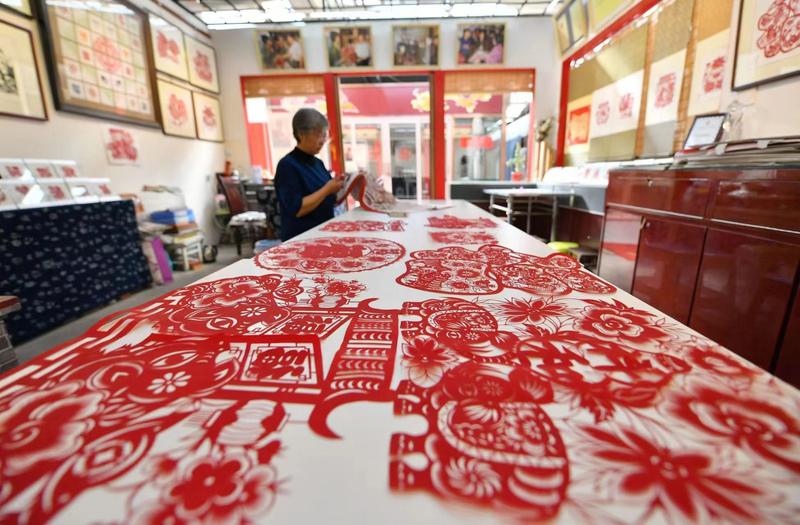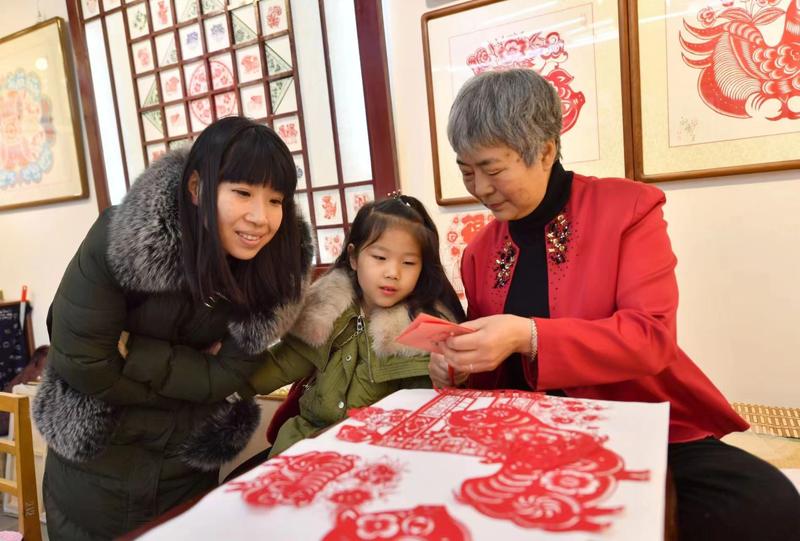 Liu Jinglan, an inheritor of Baotou-style paper-cutting, shares her passion and skills with the younger generation. (PHOTO PROVIDED TO CHINA DAILY)
Liu Jinglan, an inheritor of Baotou-style paper-cutting, shares her passion and skills with the younger generation. (PHOTO PROVIDED TO CHINA DAILY)
Within a dozen seconds and using only a pair of scissors and a piece of paper, Liu Jinglan cuts out the shape of a rabbit. A few minutes later, she has finished, the rabbit's ears and body crisscrossed with ornate patterns. When the rabbit is pasted on the window, sun shines through the thin cuts, lighting it up.
To master paper-cutting, 68-year-old Liu has been practicing for six decades. She is an inheritor of Baotou-style paper-cutting, named after the city in Inner Mongolia autonomous region where it originated.
I believe that paper-cutting is not only a craft, but also conveys good wishes for families and the country as a whole. I inherited this skill, and I will pass it on to the younger generation.
Liu Jinglan, paper-cutting artist
The style incorporates themes of nomadic grassland life, traditionally followed by the area's inhabitants, and has been designated a national-level intangible cultural heritage by the government, earmarking it for protection and development.
Liu is an accomplished teacher and practitioner of the art form, and has won multiple paper-cutting prizes. Her designs are used on stamps, postmarks and commemorative coins. They are also featured in collections of the National Art Museum of China and the National Museum of China, and have even been used by UNESCO as representative examples of Chinese paper-cutting.
Liu is also a member of the Chinese Folk Literature and Art Association, and has visited many countries including Japan, France and Australia to present Chinese paper-cutting skills as part of cultural exchanges.
"Spectators are quite fond of my paper-cutting skill and they always gather around to watch me," Liu recalls.
Born in Gaojia village in Ulaanqab, Inner Mongolia, Liu grew up in a setting where paper-cutting culture was very much a part of everyday life. When she was a child, each family would paste paper-cuts on their wood-grid windows to celebrate Spring Festival.
"The paper-cuts were so pretty. Some families would fill all the windows of their homes with paper-cuts so that together they would form a whole pattern," Liu recalls.
 Liu Jinglan, an inheritor of Baotou-style paper-cutting, shares her passion and skills with the younger generation. (PHOTO PROVIDED TO CHINA DAILY)
Liu Jinglan, an inheritor of Baotou-style paper-cutting, shares her passion and skills with the younger generation. (PHOTO PROVIDED TO CHINA DAILY)
Paper-cut patterns include bucolic scenery, references to ancient tales, flowers or fruit, animal or human figures, and the Chinese characters for happiness or luck. They generally have auspicious meanings, expressing gratitude for a good life or hope for the future in an aesthetic way.
The technique is passed down through the generations and is usually taught to youngsters by older women in a village. The patterns and designs are inherited, too.
Girls practice with previous pieces as templates, preserving meaning and technique.
Liu describes this process in detail. As a child, the paper-cuts on the windows of her home were all cut by a woman named Aunt Guo.
When she was 7, Guo was too busy to cut for Liu's family, so Liu tried it herself. "My first paper-cuts were not pretty. I even broke some. But my mother loved them. She pasted them on our window, and told me that they looked pretty when seen from far away," Liu says.
From then on, she was the one who made all the paper-cuts at home, and she even cut for her relatives.
At that early time, paper-cutting was just a hobby. However, in 1983, when she was working at a factory in Baotou, she entered into a painting and calligraphy competition held among the employees.
"Only then did I realize that paper-cutting is considered a folk art," Liu says.
She submitted a flower pattern, painted by one of her colleagues, and they won first prize, which encouraged her to find more outlets for her skill beyond just celebrating Chinese New Year.
 Most of Liu Jinglan's works feature auspicious patterns, such as rabbits, fish, flowers and Chinese character fu. (PHOTO PROVIDED TO CHINA DAILY)
Most of Liu Jinglan's works feature auspicious patterns, such as rabbits, fish, flowers and Chinese character fu. (PHOTO PROVIDED TO CHINA DAILY)
From then on, paper-cutting became a part of her daily life. For instance, her colleagues would ask her to cut pieces for their weddings and other auspicious occasions.
Her daughter, Zhao Yifan, remembers that, when she was in middle school, every day she would return home to find her mother sitting at a desk, practicing.
Zhao, 41, has followed in her mother's footsteps, and since middle school has mastered the scissors herself, majoring in arts and crafts in college and later becoming a paper-cutting teacher at a local children's activity center.
"I think my mother's paper-cuts are particularly graceful and exquisite," Zhao says.
"Her pieces look so pretty because all the elements match one another and contain folk symbolism. It has taken her years of practice and patience to master the skill."
After retirement in 2005, Liu set up a stall at a local art market to sell her works.
Ten years later, she expanded it into a 30-square-meter studio, where she teaches young students the craft of paper-cutting.
She often visits her village to collect samples to better preserve them. At the same time, she is working on using Baotou-style paper-cutting in innovative ways.
One of her favorite works is named Auspicious Grassland, which records the lives of the Mongolian people.
The inspiration for the piece was a trip to the grasslands of Inner Mongolia. The piece connects flowers, grass, nomads and sheep with auspicious signs from Mongolian culture. It took her two years to complete.
"I believe that paper-cutting is not only a craft, but also conveys good wishes for families and the country as a whole. I inherited this skill, and I will pass it on to the younger generation," Liu says.


